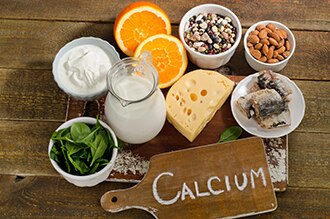Lactose Intolerance
Return to Overview PageDefinition & Facts
In this section:
- What is lactose intolerance?
- How common is lactose malabsorption?
- Who is more likely to have lactose intolerance?
- What are the complications of lactose intolerance?
What is lactose intolerance?
Lactose intolerance is a condition in which you have digestive symptoms—such as bloating, diarrhea, and gas—after you consume foods or drinks that contain lactose. Lactose is a sugar that is naturally found in milk and milk products, like cheese or ice cream.
In lactose intolerance, digestive symptoms are caused by lactose malabsorption. Lactose malabsorption is a condition in which your small intestine cannot digest, or break down, all the lactose you eat or drink.
Not everyone with lactose malabsorption has digestive symptoms after they consume lactose. Only people who have symptoms are lactose intolerant.
Most people with lactose intolerance can consume some amount of lactose without having symptoms. Different people can tolerate different amounts of lactose before having symptoms.
Lactose intolerance is different from a milk allergy. A milk allergy is an immune system disorder.

How common is lactose malabsorption?
While most infants can digest lactose, many people begin to develop lactose malabsorption—a reduced ability to digest lactose—after infancy. Experts estimate that about 68 percent of the world’s population has lactose malabsorption.1
Lactose malabsorption is more common in some parts of the world than in others. In Africa and Asia, most people have lactose malabsorption. In some regions, such as northern Europe, many people carry a gene that allows them to digest lactose after infancy, and lactose malabsorption is less common.1,2 In the United States, about 36 percent of people have lactose malabsorption.1
While lactose malabsorption causes lactose intolerance, not all people with lactose malabsorption have lactose intolerance.
Who is more likely to have lactose intolerance?
You are more likely to have lactose intolerance if you are from, or your family is from, a part of the world where lactose malabsorption is more common. In the United States, the following ethnic and racial groups are more likely to have lactose malabsorption:
- African Americans
- American Indians
- Asian Americans
- Hispanics/Latinos
Because these ethnic and racial groups are more likely to have lactose malabsorption, they are also more likely to have the symptoms of lactose intolerance.
Lactose intolerance is least common among people who are from, or whose families are from, Europe.
What are the complications of lactose intolerance?
Lactose intolerance may affect your health if it keeps you from getting enough nutrients, such as calcium and vitamin D. Milk and milk products, which contain lactose, are some of the main sources of calcium, vitamin D, and other nutrients.
You need calcium throughout your life to grow and have healthy bones. If you don’t get enough calcium, your bones may become weak and more likely to break. This condition is called osteoporosis. If you have lactose intolerance, you can change your diet to make sure you get enough calcium while also managing your symptoms.
References
Symptoms & Causes
What are the symptoms of lactose intolerance?
If you have lactose intolerance, you may have symptoms within a few hours after you have milk or milk products, or other foods that contain lactose. Your symptoms may include
Your symptoms may be mild or severe, depending on how much lactose you have.

What causes lactose intolerance?
Lactose intolerance is caused by lactose malabsorption. If you have lactose malabsorption, your small intestine makes low levels of lactase—the enzyme that breaks down lactose—and can’t digest all the lactose you eat or drink.
The undigested lactose passes into your colon. Bacteria in your colon break down the lactose and create fluid and gas. In some people, this extra fluid and gas causes lactose intolerance symptoms.
In some cases, your genes are the reason for lactose intolerance. Genes play a role in the following conditions, and these conditions can lead to low levels of lactase in your small intestine and lactose malabsorption:
- Lactase nonpersistence. In people with lactase nonpersistence, the small intestine makes less lactase after infancy. Lactase levels get lower with age. Symptoms of lactose intolerance may not begin until later childhood, the teen years, or early adulthood. Lactase nonpersistence, also called primary lactase deficiency, is the most common cause of low lactase levels.
- Congenital lactase deficiency. In this rare condition, the small intestine makes little or no lactase, starting at birth.
Not all causes of lactose intolerance are genetic. The following can also lead to lactose intolerance:
- Injury to the small intestine. Infections, diseases, or other conditions that injure your small intestine, like Crohn’s disease or celiac disease, may cause it to make less lactase. Treatments—such as medicines, surgery, or radiation therapy—for other conditions may also injure your small intestine. Lactose intolerance caused by injury to the small intestine is called secondary lactose intolerance. If the cause of the injury is treated, you may be able to tolerate lactose again.
- Premature birth. In premature babies, or babies born too soon, the small intestine may not make enough lactase for a short time after birth. The small intestine usually makes more lactase as the baby gets older.
What is the difference between lactose intolerance and milk allergies?
Lactose intolerance and milk allergies are different conditions with different causes. Lactose intolerance is caused by problems digesting lactose, the natural sugar in milk. In contrast, milk allergies are caused by your immune system’s response to one or more proteins in milk and milk products.
A milk allergy most often appears in the first year of life, while lactose intolerance typically appears later.3,4 Lactose intolerance can cause uncomfortable symptoms, while a serious allergic reaction to milk can be life threatening.
References
Diagnosis
How do doctors diagnose lactose intolerance?
To diagnose lactose intolerance, your doctor will ask about your symptoms, family and medical history, and eating habits.
Your doctor may perform a physical exam and tests to help diagnose lactose intolerance or to check for other health problems. Other conditions, such as irritable bowel syndrome, celiac disease, inflammatory bowel disease, or small bowel bacterial overgrowth can cause symptoms similar to those of lactose intolerance.
Your doctor may ask you to stop eating and drinking milk and milk products for a period of time to see if your symptoms go away. If your symptoms don’t go away, your doctor may order additional tests.
Physical exam
During a physical exam, your doctor may
- check for bloating in your abdomen
- use a stethoscope to listen to sounds within your abdomen
- tap on your abdomen to check for tenderness or pain

What tests do doctors use to diagnose lactose intolerance?
Your doctor may order a hydrogen breath test to see how well your small intestine digests lactose.
Hydrogen breath test
Doctors use this test to diagnose lactose malabsorption and lactose intolerance. Normally, a small amount of hydrogen, a type of gas, is found in your breath. If you have lactose malabsorption, undigested lactose causes you to have high levels of hydrogen in your breath.
For this test, you will drink a liquid that contains a known amount of lactose. Every 30 minutes over a few hours, you will breathe into a balloon-type container that measures the amount of hydrogen in your breath. During this time, a health care professional will ask about your symptoms. If both your breath hydrogen levels rise and your symptoms get worse during the test, your doctor may diagnose lactose intolerance.
Treatment
How can I manage my lactose intolerance symptoms?
In most cases, you can manage the symptoms of lactose intolerance by changing your diet to limit or avoid foods and drinks that contain lactose, such as milk and milk products.
Some people may only need to limit the amount of lactose they eat or drink, while others may need to avoid lactose altogether. Using lactase products can help some people manage their symptoms.
Lactase products
Lactase products are tablets or drops that contain lactase, the enzyme that breaks down lactose. You can take lactase tablets before you eat or drink milk products. You can also add lactase drops to milk before you drink it. The lactase breaks down the lactose in foods and drinks, lowering your chances of having lactose intolerance symptoms.
Check with your doctor before using lactase products. Some people, such as young children and pregnant and breastfeeding women, may not be able to use them.

How do doctors treat lactose intolerance?
Treatments depend on the cause of lactose intolerance. If your lactose intolerance is caused by lactase nonpersistence or congenital lactase deficiency, no treatments can increase the amount of lactase your small intestine makes. Your doctor can help you change your diet to manage your symptoms.
If your lactose intolerance is caused by an injury to your small intestine, your doctor may be able to treat the cause of the injury. You may be able to tolerate lactose after treatment.
While some premature babies are lactose intolerant, the condition usually improves without treatment as the baby gets older.
Eating, Diet, & Nutrition
How should I change my diet if I have lactose intolerance?
Talk with your doctor or a dietitian about changing your diet to manage lactose intolerance symptoms while making sure you get enough nutrients. If your child has lactose intolerance, help your child follow the dietary plan recommended by a doctor or dietitian.
To manage your symptoms, you may need to reduce the amount of lactose you eat or drink. Most people with lactose intolerance can have some lactose without getting symptoms.
Foods that contain lactose
You may not need to completely avoid foods and beverages that contain lactose—such as milk or milk products. If you avoid all milk and milk products, you may get less calcium and vitamin D than you need.
People with lactose intolerance can handle different amounts of lactose. Research suggests that many people could have 12 grams of lactose—the amount in about 1 cup of milk—without symptoms or with only mild symptoms.5,6
You may be able to tolerate milk and milk products if you
- drink small amounts of milk at a time and have it with meals
- add milk and milk products to your diet a little at a time and see how you feel
- try eating yogurt and hard cheeses, like cheddar or Swiss, which are lower in lactose than other milk products
- use lactase products to help digest the lactose in milk and milk products

Lactose-free and lactose-reduced milk and milk products
Using lactose-free and lactose-reduced milk and milk products may help you lower the amount of lactose in your diet. These products are available in many grocery stores and are just as healthy for you as regular milk and milk products.
Calcium and Vitamin D
If you are lactose intolerant, make sure you get enough calcium and vitamin D each day. Milk and milk products are the most common sources of calcium.
Many foods that do not contain lactose are also sources of calcium. Examples include:
- fish with soft bones, such as canned salmon or sardines
- broccoli and leafy green vegetables
- oranges
- almonds, Brazil nuts, and dried beans
- tofu
- products with labels that show they have added calcium, such as some cereals, fruit juices, and soy milk

Vitamin D helps your body absorb and use calcium. Be sure to eat foods that contain vitamin D, such as eggs and certain kinds of fish, such as salmon. Some ready-to-eat cereals and orange juice have added vitamin D. Some milk and milk products also have added vitamin D. If you can drink small amounts of milk or milk products without symptoms, choose products that have added vitamin D. Also, being outside in the sunlight helps your body make vitamin D.
Talk with your doctor or dietitian about whether you are getting the nutrients you need. For safety reasons, also talk with your doctor before using dietary supplements or any other complementary or alternative medicines or practices. Also talk with your doctor about sun exposure and sun safety.
What foods and drinks contain lactose?
Lactose is in all milk and milk products and may be found in other foods and drinks.
Milk and milk products may be added to boxed, canned, frozen, packaged, and prepared foods. If you have symptoms after consuming a small amount of lactose, you should be aware of the many products that may contain lactose, such as
- bread and other baked goods, such as pancakes, biscuits, cookies, and cakes
- processed foods, including breakfast cereals, instant potatoes, soups, margarine, salad dressings, and flavored chips and other snack foods
- processed meats, such as bacon, sausage, hot dogs, and lunch meats
- milk-based meal replacement liquids and powders, smoothies, and protein powders and bars
- nondairy liquid and powdered coffee creamers, and nondairy whipped toppings
You can check the ingredient list on packaged foods to see if the product contains lactose. The following words mean that the product contains lactose:
- milk
- lactose
- whey
- curds
- milk by-products
- dry milk solids
- nonfat dry milk powder
A small amount of lactose may be found in some prescription and over-the-counter medicines. Talk with your doctor about the amount of lactose in medicines you take, especially if you typically cannot tolerate even small amounts of lactose.
References
Clinical Trials
The National Institute of Diabetes and Digestive and Kidney Diseases (NIDDK) and other components of the National Institutes of Health (NIH) conduct and support research into many diseases and conditions.
What are clinical trials, and are they right for you?
Clinical trials are part of clinical research and at the heart of all medical advances. Clinical trials look at new ways to prevent, detect, or treat disease. Researchers also use clinical trials to look at other aspects of care, such as improving the quality of life for people with chronic illnesses. Find out if clinical trials are right for you.
Watch a video of NIDDK Director Dr. Griffin P. Rodgers explaining the importance of participating in clinical trials.
What clinical trials are open?
Clinical trials that are currently open and are recruiting can be viewed at ClinicalTrials.gov.
This content is provided as a service of the National Institute of Diabetes and Digestive and Kidney Diseases
(NIDDK), part of the National Institutes of Health. NIDDK translates and disseminates research findings to increase knowledge and understanding about health and disease among patients, health professionals, and the public. Content produced by NIDDK is carefully reviewed by NIDDK scientists and other experts.
The NIDDK would like to thank:
Rachel Fisher, M.S., M.P.H., R.D., NIDDK Office of Nutrition Research

